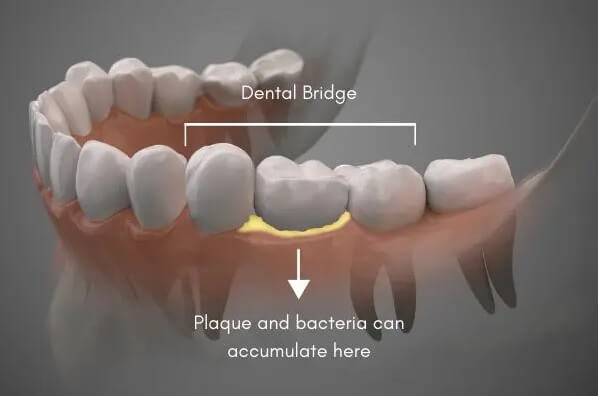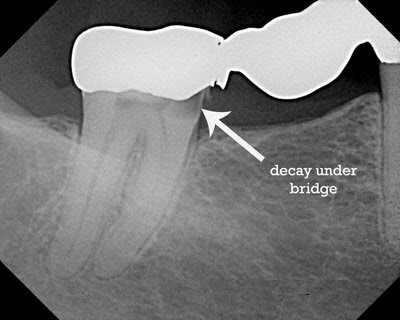A Cavity Under A Bridge

What Is A Cavity Under A Bridge?
A Dental Bridge is an effective way to replace missing teeth, using crowns to support an artificial tooth between them. However, just like natural teeth, cavities can form beneath a dental bridge, causing significant oral health problems.
A cavity under a dental bridge occurs when tooth decay forms in the supporting teeth underneath. Factors such as poor oral hygiene, plaque buildup, and trapped food particles contribute to decay under a bridge. If not treated, the cavity can loosen or dislodge the bridge, potentially leading to further tooth decay, gum disease, and discomfort.
Before you book an appointment with your Toronto dentist, here’s everything you need to know about cavities under dental bridges:
- Why Do Cavities Form Under a Dental Bridge?
- Signs And Symptoms Of A Cavity Under A Bridge
- Treatment Options For A Cavity Under A ridge
- Managing A Cavity Under A Bridge Until You Can See The Dentist
- Cavity Risk Self Quiz
- Frequently Asked Questions About Cavities Under Dental Bridges
If you have questions about A Cavity Under A Bridge or other dental problems, please contact us for more information.
Why Do Cavities Form Under a Dental Bridge?
There are several common causes of cavities developing under a dental bridge:
- Poor Oral Hygiene: If you don’t brush and floss effectively, plaque and bacteria can accumulate and lead to cavities.
- Trapped Food Debris: Food that gets stuck between the bridge and supporting teeth creates an ideal environment for bacterial growth, increasing the risk of decay.
- Diet: Acidic and sugary foods weaken tooth enamel, making teeth more prone to decay.
- Improperly Fitted Bridge: A poorly fitted bridge can leave gaps where bacteria and food particles can accumulate, leading to cavities.
Maintaining excellent oral hygiene and having your bridge checked regularly by your dentist can reduce the risk of cavities forming underneath. If you have further questions about A Cavity Under A Bridge, please contact us.
Signs And Symptoms Of A Cavity Under A Bridge
Recognizing the signs of a cavity under your bridge is crucial for early treatment. Here are the symptoms to watch for:
- Tooth Sensitivity: Increased sensitivity to hot or cold temperatures.
- Pain or Discomfort: Pain when biting or chewing can indicate decay.
- Bad Breath: Persistent bad breath is often a sign of bacterial buildup under the bridge.
- Gum Swelling: Redness or swelling of the gums around the bridge area.
- Visible Holes: Small black spots or pits might be visible on the teeth beneath the bridge.
If you notice any of these symptoms, schedule an appointment with your dentist to prevent the cavity from worsening. If you have further questions about A Cavity Under A Bridge, please contact us.

Treatment Options For A Cavity Under A Bridge
The treatment for a cavity under a bridge depends on the severity of the decay. Common treatment options include:
- Dental Filling: If the cavity is small and easily accessible, your dentist can remove the decay and fill it.
- Root Canal Treatment: When decay reaches the tooth’s pulp, root canal treatment is needed to remove the infected tissue, and a new bridge may be required.
- Bridge Replacement: If the cavity is extensive, the current bridge may need to be removed and replaced.
- Tooth Extraction: In severe cases, the decayed tooth may need to be extracted, followed by a new bridge or dental implant to replace it.
It’s essential to consult with your dentist to determine the best treatment based on your individual case. If you have further questions about your treatment options for A Cavity Under A Bridge, please contact us.
Managing A Cavity Under A Bridge Until You Can See The Dentist
If you suspect you have a cavity under your dental bridge and can’t see a dentist immediately, here’s how to manage the symptoms:
- Take Over-the-Counter Pain Medication: Ibuprofen or acetaminophen can help relieve pain. Follow dosage instructions carefully.
- Keep the Bridge Area Clean: Use a floss threader or water flosser to gently clean around the bridge. Rinsing with salt water can reduce inflammation.
- Avoid Hot or Cold Foods: Stick to room-temperature or soft foods to avoid aggravating sensitivity.
- Use Dental Wax: If your bridge is causing gum irritation, dental wax can provide temporary relief.
These are temporary solutions, and it’s essential to visit your dentist as soon as possible for proper treatment. If you have further questions about A Cavity Under A Bridge, please contact us.
Cavity Risk Self Quiz
Try Our free online dental caries risk assessment quiz based on the California Dental Association’s Caries Management by Risk Assessment (CAMBRA) designed for patients aged 6 years and older. This caries risk assessment tool is meant to give you an idea of your level of dental caries risk, and by no means substitute for an oral exam by a dental professional. Please contact us for a more complete examination.
Frequently Asked Questions About Cavities Under Dental Bridges
- Can a cavity under a bridge be treated without removing the bridge?
In some cases, small cavities near the edges can be treated without removing the bridge. However, extensive decay often requires removing the bridge to access and repair the affected area.
- How long does it take for a cavity under a bridge to form?
Cavities can develop over months or years, depending on oral hygiene and dietary habits. Regular dental visits can help detect and address cavities before they become severe.
- Can a cavity under a bridge cause the bridge to fail?
Yes, untreated cavities can weaken the supporting teeth, potentially leading to bridge failure. Early treatment is essential to preserve the bridge and underlying teeth.
- Are X-rays necessary to detect a cavity under a bridge?
Yes, Bitewing x-rays are often needed to identify cavities hidden beneath a bridge. They provide detailed images that can reveal decay not visible during a standard exam.
Cavities under dental bridges can compromise both the bridge and the supporting teeth if left untreated, but early detection can save you from extensive dental work. Regular dental checkups and proper oral hygiene are key to preventing and managing this issue effectively. Contact us for more information

